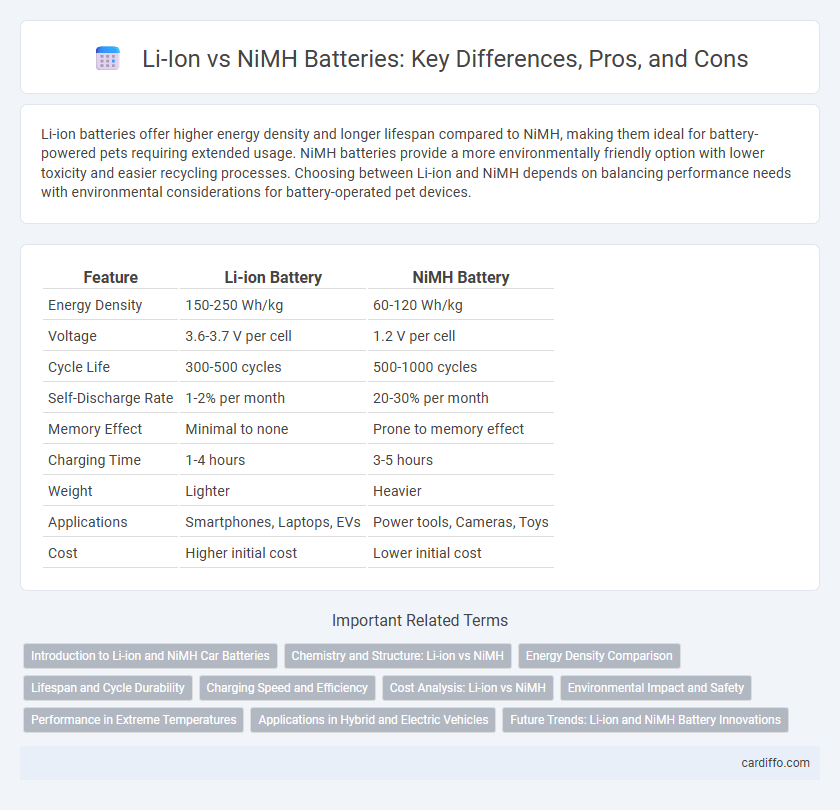Li-ion batteries offer higher energy density and longer lifespan compared to NiMH, making them ideal for battery-powered pets requiring extended usage. NiMH batteries provide a more environmentally friendly option with lower toxicity and easier recycling processes. Choosing between Li-ion and NiMH depends on balancing performance needs with environmental considerations for battery-operated pet devices.
Table of Comparison
| Feature | Li-ion Battery | NiMH Battery |
|---|---|---|
| Energy Density | 150-250 Wh/kg | 60-120 Wh/kg |
| Voltage | 3.6-3.7 V per cell | 1.2 V per cell |
| Cycle Life | 300-500 cycles | 500-1000 cycles |
| Self-Discharge Rate | 1-2% per month | 20-30% per month |
| Memory Effect | Minimal to none | Prone to memory effect |
| Charging Time | 1-4 hours | 3-5 hours |
| Weight | Lighter | Heavier |
| Applications | Smartphones, Laptops, EVs | Power tools, Cameras, Toys |
| Cost | Higher initial cost | Lower initial cost |
Introduction to Li-ion and NiMH Car Batteries
Li-ion car batteries offer higher energy density, longer cycle life, and faster charging compared to NiMH batteries, making them ideal for modern electric vehicles. NiMH batteries are known for their durability, thermal stability, and cost-effectiveness, often used in hybrid cars due to reliable performance under various conditions. Both battery types impact vehicle weight, range, and efficiency, influencing the overall driving experience and maintenance needs.
Chemistry and Structure: Li-ion vs NiMH
Li-ion batteries utilize a lithium cobalt oxide or lithium iron phosphate cathode with a graphite anode, enabling higher energy density through efficient lithium-ion intercalation. NiMH batteries employ a metal hydride anode and a nickel oxyhydroxide cathode, which results in lower energy density but offers better thermal stability. The solid-state electrolyte in NiMH contrasts with the liquid organic electrolyte in Li-ion, affecting safety and charge retention characteristics.
Energy Density Comparison
Li-ion batteries offer significantly higher energy density, typically ranging from 150 to 250 Wh/kg, compared to NiMH batteries which usually provide around 60 to 120 Wh/kg. This higher energy density allows Li-ion batteries to store more energy in a smaller, lighter package, making them ideal for applications requiring long battery life and compact design, such as smartphones and electric vehicles. NiMH batteries, although lower in energy density, are often used in power tools and hybrid vehicles due to their robustness and ability to deliver high current output.
Lifespan and Cycle Durability
Li-ion batteries typically offer a longer lifespan of 8 to 10 years with cycle durability ranging from 300 to 500 full charge cycles before capacity significantly degrades. NiMH batteries generally have a shorter lifespan of 3 to 5 years and support approximately 500 to 1000 charge cycles, but their capacity decreases faster over time due to memory effect. The superior energy density and lower self-discharge rate of Li-ion cells contribute to better retention of charge capacity compared to NiMH batteries during extended use.
Charging Speed and Efficiency
Li-ion batteries exhibit faster charging speeds and higher energy efficiency compared to NiMH batteries, typically reaching full charge in 1 to 3 hours. Their superior charge retention and lower self-discharge rates enhance overall performance in portable electronics and electric vehicles. NiMH batteries, while more cost-effective, require longer charging times and have relatively higher energy losses during the charging cycle.
Cost Analysis: Li-ion vs NiMH
Li-ion batteries typically have a higher initial cost compared to NiMH batteries but offer a longer lifespan and higher energy density, resulting in lower cost per cycle over time. NiMH batteries are more affordable upfront but require more frequent replacements, increasing long-term expenses, especially in high-drain applications. When considering total cost of ownership, Li-ion batteries often provide better value due to their durability and efficiency in energy retention.
Environmental Impact and Safety
Li-ion batteries offer higher energy density and longer lifespan but pose greater environmental risks due to hazardous chemical components and complex recycling processes. NiMH batteries have a lower environmental footprint with fewer toxic metals, making disposal and recycling safer and more eco-friendly. Both battery types require careful handling to prevent overheating or leakage, yet Li-ion cells are more prone to thermal runaway, impacting overall safety.
Performance in Extreme Temperatures
Li-ion batteries maintain higher energy density and better capacity retention in extreme temperatures compared to NiMH cells, which tend to suffer from reduced efficiency and faster self-discharge rates under the same conditions. Li-ion chemistry provides superior thermal stability and discharge performance in cold environments, making them ideal for devices exposed to harsh climates. NiMH batteries generally experience significant voltage drops and shorter runtimes when subjected to sub-zero or high heat conditions, limiting their effectiveness in extreme temperature applications.
Applications in Hybrid and Electric Vehicles
Li-ion batteries dominate hybrid and electric vehicle markets due to their higher energy density and longer cycle life compared to NiMH batteries. NiMH batteries, although less energy-dense, offer robust thermal stability and cost advantages, making them favorable for conventional hybrid systems with moderate power demands. Advances in Li-ion technology continue to expand their application in full electric vehicles, whereas NiMH remains relevant in hybrid models prioritizing reliability and lower production costs.
Future Trends: Li-ion and NiMH Battery Innovations
Li-ion batteries continue to dominate energy storage advancements due to higher energy density and longer lifecycle improvements, with innovations in solid-state electrolytes and silicon anode materials enhancing safety and capacity. NiMH technology evolves through hybrid cathode development and improved electrode design, targeting specific applications like hybrid electric vehicles where cost-effectiveness and environmental considerations remain pivotal. Future trends emphasize integrating AI-driven battery management systems for both Li-ion and NiMH to optimize performance, extend lifespan, and enable smarter energy utilization across diverse industries.
Li-ion vs NiMH Infographic

 cardiffo.com
cardiffo.com